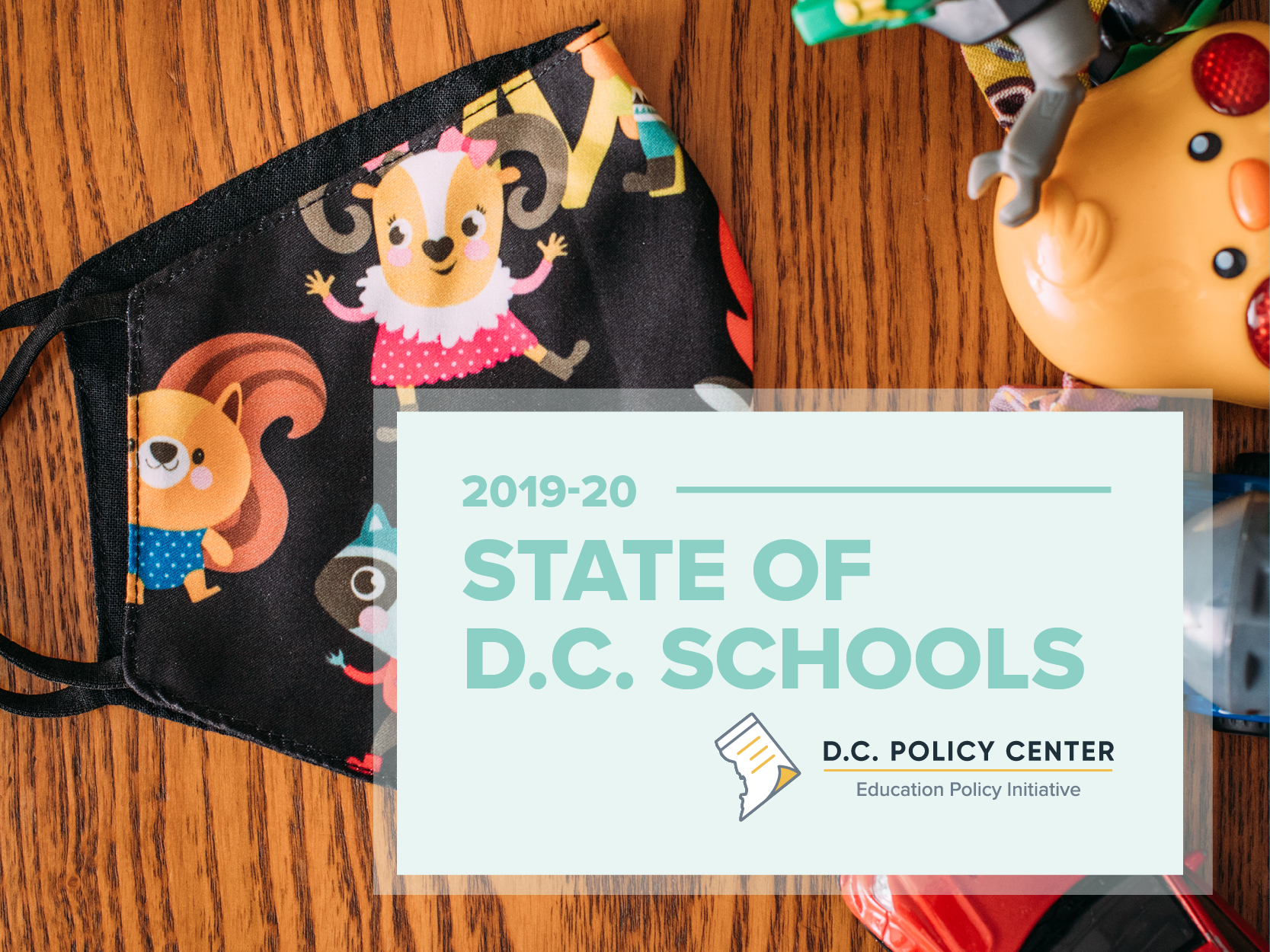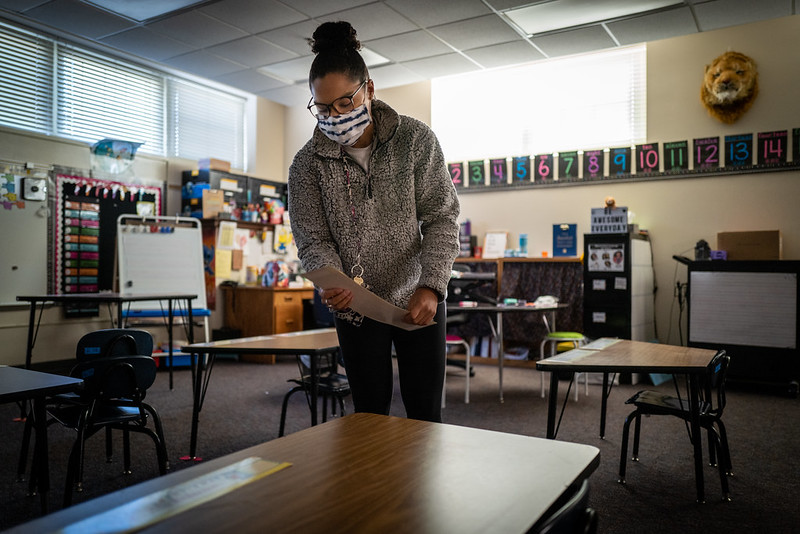State of D.C. Schools, 2019-20 is an annual systemwide overview of education in the District of Columbia. Its main purpose is to give D.C. residents, parents, caregivers, and other stakeholders a snapshot of the overall performance of the District’s public schools.
This is a web-friendly adaptation of the original PDF report. You may also wish to read:
Report Highlights (English) – Puntos Importantes y Resumen del Informe (Español)
Launch event: Find information on the March 16, 2021 virtual launch event, including a recording and Spanish-language transcript, here.
Table of Contents
- About & Acknowledgements
- Introduction
- Schools and students in school year 2019-20
- Distance learning in spring of 2020
- Looking ahead to school year 2020-21 and beyond
- Data sources
- Endnotes
About & Acknowledgements
About the D.C. Policy Center
The D.C. Policy Center is a non-partisan, independent 501(c)(3) think tank focused on advancing policies for a vibrant and growing economy in the District of Columbia. The D.C. Policy Center is dedicated to providing objective, targeted, and high-quality data analyses to support a rigorous and productive policy debate.
About this report
State of D.C. Schools is an annual systemwide overview of education in the District of Columbia. The report’s main purpose is to give D.C. residents, parents, caregivers, policymakers, and other stakeholders a snapshot of the overall performance of the District’s public schools.
Since the last school year, the COVID-19 pandemic has dramatically altered public education in D.C. Therefore, this year’s report examines how students, families, and schools are navigating distance learning. The focus of the report is school year 2019-20, but some of our findings also reflect the experiences of the current school year.
We hope that this State of D.C. Schools report will help inform local education policymakers in the development of future policy decisions as we recover from COVID-19.
The views expressed in this report are those of D.C. Policy Center researchers and experts and should not be attributed to members of the D.C. Policy Center’s Board of Directors or its funders.
Other reports in this series
State of D.C. Schools, 2018-19
Acknowledgements
This report was prepared with generous support from Education Forward DC. The report also benefited from comments provided by a group of community advisors and other reviewers, including staff or representatives from District of Columbia Public Schools (DCPS), the Office of the Deputy Mayor for Education (DME), the Ombudsman for Public Education, the Office of the State Superintendent of Education (OSSE), Community College Preparatory Academy PCS, Digital Equity in DC Education, the Flamboyan Foundation, KIPP DC PCS, and Van Ness ES. Their review in no way indicates an endorsement of this report, and all errors are the responsibility of the D.C. Policy Center authors.
We are deeply grateful to the individuals and schools who provided the photos appearing throughout this report.
Introduction
The novel coronavirus pandemic, its resulting spring 2020 school closures, and the stay-at-home orders that followed brought unprecedented changes to the District of Columbia during school year 2019-20. With little time to prepare, D.C. students, families, and educators shifted to distance learning at both District of Columbia Public Schools, or DCPS, and public charter schools. All public schools closed for in-person instruction in mid-March of 2020 and remained fully virtual for the remainder of the school year.
The pandemic put the District’s public schools through a stress test and imposed rapid changes on how students learn in public schools. As schools largely moved to a virtual space, inequitable access to devices and internet made it more difficult for some students to engage and learn remotely, especially before systemwide efforts were put in place to provide this technology. Students who receive additional supports, such as English learners or students with disabilities, found it harder to access the services they needed. The isolation and economic insecurity that transpired for some families presented challenges to socioemotional well-being, health, and finances in students’ households. School year 2019-20 ended with much uncertainty about the impact of this pandemic on students or the timeline within which students will return to in-person school. Distance learning continued for most students in school year 2020-21 (when this report was written).
The transition to online learning and loss of time in a school building resulted in critical learning losses and amplified inequities. But with time, schools, teachers, students, and families also discovered ways to adapt and found elements of resiliency and reason for hope. This report aims to capture experiences during this time, chronicling how students, families, teachers, and schools responded to the COVID-19 pandemic and the accompanying challenges during the spring of 2020. It also provides an update on distance learning in school year 2020-21.[i]
Much of the analysis and information presented in this report relies on qualitative findings from focus groups conducted by the D.C. Policy Center. The D.C. Policy Center heard from 57 participants over seven focus groups, including parents, high school students, teachers, and adult learners. Each focus group participated in two rounds of conversations: in the first round, the main goal was to hear about distance learning in the spring of 2020, and in the second round, the goal was to find out how learning had changed in the fall of 2020. The observations and comments of focus group participants have been incorporated into the report.
The report has three main sections. The first section examines schools and enrollment in school year 2019-20 to identify students who might have been affected by the pandemic more severely than their peers. The second section reviews experiences with distance learning in the spring of 2020, sharing the system response, key challenges, and lessons learned. A third and final section takes stock of how the education community found ways to be resilient and adaptive in the fall of 2020 and includes a look ahead toward recovery.
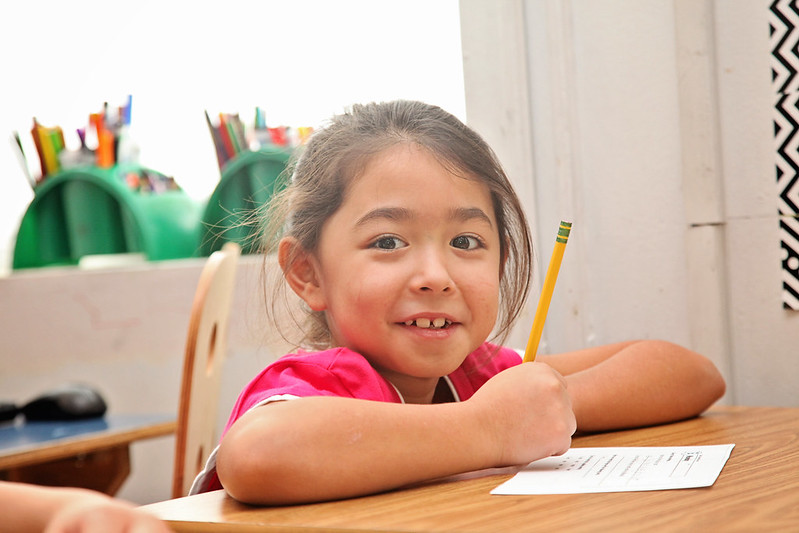
Schools and students in school year 2019-20
School year 2019-20 brought extraordinary challenges to education in D.C. This section provides a summary of where schools and students started the school year and reviews the impacts of the pandemic during spring 2020.
Schools and enrollment
In school year 2019-20, there were 240 DCPS and public charter schools—one more than the previous year—serving students in all grades. These 240 schools were almost equally distributed between DCPS and public charter schools: 117 were DCPS schools and 123 were public charter schools managed by 62 Local Education Agencies (LEAs).
At the beginning of the school year, enrollment in the city’s public schools rose to 94,412 students, including 86,934 students in pre-kindergarten through grade 12.[ii] Over half of these students were in pre-kindergarten or elementary school grades, ages when students generally need more hands-on guidance from parents and caregivers to participate in distance learning.
Beyond pre-kindergarten to grade 12 enrollment, an additional 7,100 students enrolled in adult and alternative schools[iii] which served students who were often managing other responsibilities such as childcare and employment, a juggling act further complicated by the pandemic. As part of the total, there were also 378 students attending schools designated exclusively for students with disabilities.
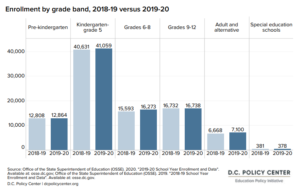
Enrollment data based on the fall 2019 audit (conducted before the onset of the pandemic) showed growth from a year earlier: 1,170 more pre-kindergarten to grade 12 students enrolled in DCPS and public charter schools in the fall of 2019, representing one percent growth over the previous year. But that growth was slower than other recent years: between 2014-15 and 2018- 19 school years, enrollment grew by an average of two percent or approximately 1,700 students from year to year. Enrollment in school year 2019-20 grew the most in middle school grades and at adult and alternative schools, increasing by four and six percent, respectively.
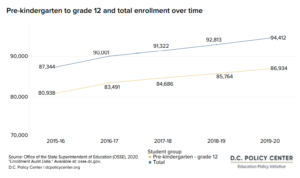
Overall, 54 percent of students were enrolled at DCPS schools and 46 percent of students were enrolled in public charter schools in school year 2019-20. This meant that when distance learning began in March of 2020, about half of students– those attending DCPS schools—were part of a large LEA making centralized decisions about plans and systems to guide remote instruction, and the other half were at smaller public charter LEAs that created their own distance learning plans.[iv] DCPS schools enrolled a higher number of students than public charter schools at every grade level between kindergarten and grade 12, but especially in elementary school grades. In contrast, public charter schools enrolled a greater share of pre-kindergarten students, and adult and alternative learners.
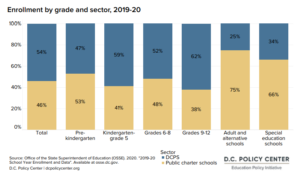
Special student populations
When the school year began in fall of 2019, shifts in the composition of the student body continued along the trends from previous years: English learners and students with disabilities made up larger shares of enrollment in school year 2019-20 than in 2018-19. English learners represented 13 percent of students, and 16 percent of students were identified as having disabilities—both groups usually receive additional services that became more difficult to deliver remotely. Additionally, in school year 2019-20, 43 percent of students were considered “at-risk” under a local statutory designation covering students who receive certain public benefits, experience homelessness, are in the foster care system, or are over-age in high school. The share of students designated as at-risk decreased over the past two years, also continuing the trend from previous years.
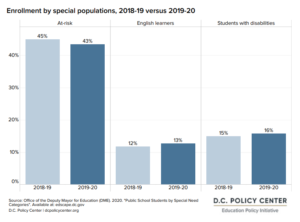
Importantly, 5,122 students experienced homelessness, which complicated distance learning, as these students were less likely to have reliable access to internet.[v]
Race and ethnicity of students
Students of color represented 88 percent of enrollment in D.C. in school year 2019-20. Compared to school year 2018-19, the share of Black students decreased by one percentage point, while the share of Latino and white students increased by one percentage point each. These correspond to trends over previous years.
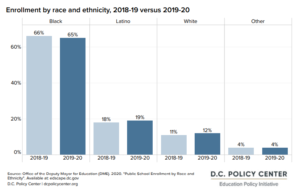
Teachers, nurses, and mental health professionals
Nothing prepared teachers for the abrupt mid-year shift to distance learning, but at least the majority (92 percent) of the 7,659 teachers[vi] had been teaching for more than a year. During school year 2019-20, most teachers (63 percent) in D.C. had at least six years of teaching experience.
Teacher experience was consistent across schools—schools at which 50 percent or more of students qualify for certain public benefits (i.e. TANF and SNAP), are in foster care, or experience homelessness—had about the same percent of teachers at each level of experience as low-poverty schools in school year 2019-20.
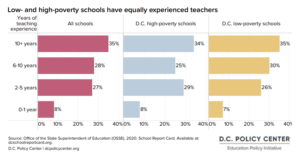
On average, school nurses or allied health professionals were available at 93 percent of pre-kindergarten to grade 12 schools (203 schools) in school year 2019-20. School nurses (part-time or full-time) or allied health professionals (including nursing assistants, medical technicians, or anyone who can support a nurse) may provide access or referrals to medical providers as well as prevention, screening, testing, or treatment services related to chronic diseases (diabetes, obesity, asthma, etc.), oral health services, vision screenings, and hearing screenings. All schools in Wards 1, 3, and 7 reported having access to a school nurse or allied health professional during school year 2019-20.
Access to basic healthcare services at school will be even more critical when students return to in-person school, considering the need for increased monitoring of student and educator health due to the lingering effects of the pandemic and, in some cases, the need for care of students who missed annual health check-ups last school year.[vii]
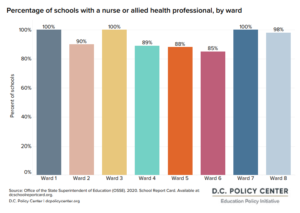
Access to mental health services has always been critical for D.C. students, but this need became even more acute during a time of heightened stress and increased isolation brought on by the pandemic and school closures.
In school year 2019-20, there was, on average, one mental health professional for every 206 pre-kindergarten to grade 12 students across the city. Schools in Ward 3 had more students per mental health professional than other wards; however, this may be because these schools tend to serve the lowest percentage of students who are considered at-risk for funding purposes, and mental health professionals are less likely to be in these schools with lower needs. In March 2020, an estimated 420 mental health professionals (including licensed professional counselors, licensed/independent social workers, psychiatrists, and psychologists)[viii] had to shift to providing services virtually.
Student well-being
The negative effects of the pandemic have been extreme in certain D.C. communities, especially those that were less stable economically before the pandemic. For example, Wards 7 and 8 had higher child poverty rates before the pandemic,[ix] and as of June 1, 2020—at the close of the school year for most students—residents of Wards 7 and 8 had been hit harder by COVID-19, accounting for 29 percent of COVID-19 cases but just 22 percent of the population. Tragically, as of June 1, 2020, Black residents comprised 47 percent of COVID-19 cases, but a disproportionate 75 percent of deaths.
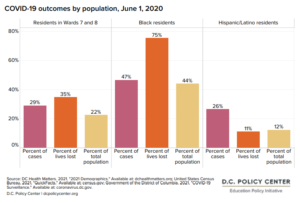
The full impact of COVID-19 on students’ mental health in D.C. isn’t known, but even before the pandemic, a large share of the District’s children and youth up to age 17 had been exposed to traumatic events with the potential to impact their mental health: 22.8 percent had been exposed to one adverse childhood experience (ACE)[x] and 21.3 percent had been exposed to two or more.[xi]
ACEs
Adverse childhood experiences, or ACEs, undermine a child’s sense of safety and stability. They include abuse, neglect, exposure to violence at home or in the community, substance misuse, and instability due to parental separation.[xii] They also include social factors such as economic hardship, homelessness, and discrimination. Decades of research link ACEs to lifelong negative health and social outcomes.[xiii] One such study found that people with four or more ACEs—one in six adults—are at increased risk for alcoholism, depression, suicide attempt, severe obesity, and other health hazards.[xiv] Another study linked ACEs to five of the top 10 leading causes of death.[xv] Exposure to ACEs may also lead to reduced educational and occupational achievement.[xvi]
Exposure to these incidents is much higher among the city’s Black and Latino children and youth: 16.6 percent of white students have been exposed to an ACE, in contrast to 58.7 percent of Black students and 38.7 percent of Latino students.[xvii]
“Unaddressed, the pandemic-induced trauma will prevent children from learning, lead to self-destructive behavior, and have a long-term impact on children’s opportunities.”
— Executive Director of a local nonprofit working on children’s issues
Living through the COVID-19 pandemic is a traumatic experience in and of itself, and may put children at greater risk of encountering other ACEs. The social isolation brought on by the pandemic also likely increases the chances of anxiety and depression among D.C.’s children and youth,[xviii] and loss of income among their parents could lead to increased economic hardship—all common ACEs. Child abuse is another ACE-related concern,[xix] as it may happen more frequently in households with parental stress,[xx] and school closures contribute to the underreporting of child abuse.[xxi]
The pandemic has exacerbated barriers to learning that some students were already experiencing before March of 2020. Given pre-existing disparities in the District, the pandemic’s impact has likely been even greater for students of color and students from low-income families compared to their peers, and the pandemic is expected to widen learning gaps.
The next section explores how these students experienced distance learning in spring 2020.
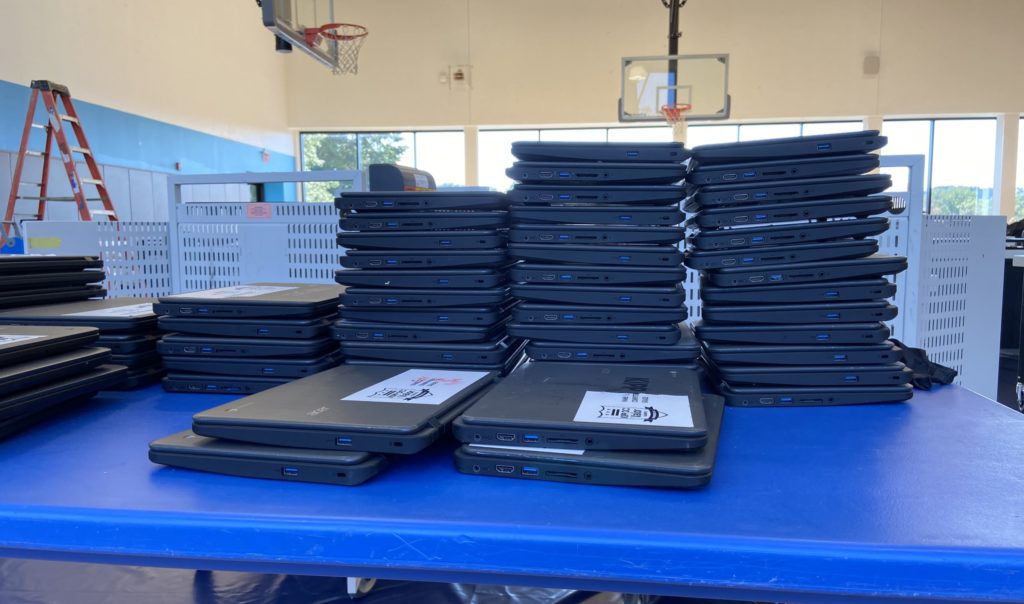
Distance learning in spring of 2020
In early March of 2020, D.C. documented its first case of COVID-19 and declared a state of emergency and a public health emergency. DCPS schools and public charter schools closed shortly after that. DCPS and some public charter schools moved their planned spring break to coincide with the first week of closures to allow for planning the shift to distance learning, which continued for the remainder of the school year. The school year ended three weeks early for DCPS and many public charter schools, on May 29, 2020.
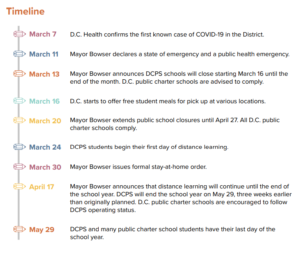
Distance learning experiences
There was significant variation in how D.C.’s education community—including students, parents, and teachers—experienced distance learning beginning in the spring of 2020. Parents and students reported varying levels of interactions with teachers and other school personnel, access to technology, and socialization among students. These differences existed across schools but also within schools, at the classroom and student level. This overview of distance learning in the spring of 2020 incorporates a review of LEAs’ distance learning plans, local surveys, focus groups conducted by the D.C. Policy Center, and other local information sources.
D.C. Policy Center focus group overview
The D.C. Policy Center (in collaboration with social research facilitator, Bridges, Inc.) conducted two rounds of focus groups and one-on-one interviews to gather information on the reactions of parents, high school students, adult learners, and teachers to distance learning. The D.C. Policy Center engaged these groups to understand their direct experiences (school leaders were not included). The perspectives shared by these focus group participants are not fully representative of each group, but their views add insights to findings from other surveys and qualitative information gathered over the past year.
The first round of interviews took place in August and September of 2020 with a focus on experiences from the spring of 2020. There were 48 participants in this round: 25 parents, 10 high school students, 6 adult learners, and 7 teachers.
- The 25 parents had children in a variety of grade levels, with 55 percent attending DCPS and 45 percent attending public charter schools. There was an intentional focus on engaging parents living in Wards 7 and 8 and Spanish-speaking parents–the 25 parents included 10 living in Wards 7 and 8, seven Spanish-speaking parents, and eight English-speaking parents living elsewhere in the District.
- Six of the 10 high school students attended DCPS schools, and four attended public charter schools. Six of the students lived in Wards 7 and 8.
- The six adult learners lived in neighborhoods across D.C., and almost all described their experiences managing their children’s learning in addition to their own.
- The seven teachers taught at schools in Wards 4, 5, 6, 7, and 8, most at DCPS schools.
In the spring of 2020, schools and families had to adjust quickly to a distance learning environment. In some cases, lack of access to devices and high-speed internet initially prevented students from fully participating in distance learning, especially in households with multiple students or with parents also working remotely, where many needed to use internet and devices at the same time.[xxii] According to distance learning plans detailing LEAs’ efforts (as of May 4, 2020),[xxiii] all schools eventually provided distance learning through web-based instruction, and some also produced paper-based packets of instructional materials for students. The subset of schools that initially opted for packet instruction later incorporated web-based programs and tools after expanding technology and internet access to their students.
The digital divide
Approximately one in every eight District residents did not have access to a computer or tablet in their household before the pandemic,[xxiv] and 24 percent of children in D.C. lacked access to broadband internet. This share was higher in Wards 7 and 8, where 37 percent of children lacked access.[xxv]
In the focus groups, some parents reported that they were initially eager to keep their children on track academically. They believed distance learning would be over before the end of the school year and wanted to make sure their children were keeping up with schoolwork in the interim period. Students in the focus group reported experiencing a lot of change, but most felt able to engage in distance learning when it began because they still remembered their normal routines. Teachers who participated in the focus groups reported that having to adapt to a whole new method of teaching with little time to prepare was difficult.
 School spotlight: Adapting to distance learning over time
School spotlight: Adapting to distance learning over time
- The first three weeks of DCPS’s distance learning plans involved extensions, enrichment, or new applications of prior learning. Over time, new material replaced review sessions as it became clear that distance learning was here to stay.
- Statesmen College Preparatory Academy for Boys PCS took the first week of distance learning to look at local and national examples of how other schools were handling closures to see what was working and to create a phased approach.
The initial experiences changed over the subsequent weeks. All parents in the focus groups reported experiencing fatigue with trying to help their students by May 2020, and students were having trouble staying engaged or connected because of technology issues. Teachers, on the other hand, felt more settled and confident in virtual environments.
Racial justice
In addition to the COVID-19 pandemic and related school closures, events of this year brought a renewed call for racial justice in D.C. and across the country. The murders of Ahmaud Arbery, Breonna Taylor, George Floyd, and many other Black Americans sparked demonstrations across the United States in the spring and summer of 2020, culminating in a nationwide movement protesting police violence and calls for local municipalities to defund, downsize, or abolish their police departments. One of the largest protests took place in Washington, D.C. Tens of thousands of protestors—the majority of whom wore masks—gathered daily at the District’s Lafayette Square for about two weeks in June. D.C. Mayor Muriel Bowser renamed a stretch of 16th Street NW near the protests, “Black Lives Matter Plaza.”[xxvi] Protesters also met in neighborhoods across the city. Most of these demonstrations were peaceful, but there were several high-profile confrontations between protestors and police in D.C. that resulted in outrage at the excessive use of force by police.
In response to these events and the appeals of advocates, the D.C. State Board of Education (DC SBOE) adopted a resolution in July 2020 calling for the removal of all police from DCPS schools and public charter schools. DC SBOE also recommended that each school be given time to develop a plan for alternative systems that would maintain a safe and supportive learning environment in the absence of police presence. In addition, the D.C. Council passed a budget proposal in June 2020 that would make DC Public Schools responsible for security guards instead of the Metropolitan Police Department, in response to activists’ calls for police-free schools.
Parents
The need to spend more time with younger children and the difficulty of doing so while working remotely or away from the home was a common theme for the parents who participated in the focus groups. Parents reported they had to maintain their children’s interest in school, identify and engage in learning-related activities, and even relearn content to support learning. The demand on parents’ time was less intense for older children, who could be more self-motivated and were less in need of adult supervision.
Beyond that, parent experiences with distance learning showed more variety: some were focused on the extent to which their children interacted with teachers and other school personnel; others mentioned lack of access to technology; and yet others worried about the lack of socialization among students. Despite these disparate concerns related to distance learning, there was agreement that the challenges of distance learning—for students, parents, and educators—were understandable, especially at the onset of the experience in March.
 School spotlight: Scheduling virtual classes
School spotlight: Scheduling virtual classes
- At DCPS, elementary schools recommended about two hours of learning activities per day, which increased to around three hours per day of instruction in middle and high schools.
- At D.C. Scholars PCS, a pre-kindergarten to grade 8 public charter school, educators found that older students were better at engaging in live sessions where students could interact with the teacher and each other, whereas younger students needed pre-recorded lessons that their families could access to assist with instruction when it was most convenient.
- At Friendship PCS, high school students followed their course schedules with classes online from 9am to 3pm.
Spanish-speaking parents
To better understand the experiences of parents who were Spanish speakers, the D.C. Policy Center conducted one focus group in Spanish. Most participants reported great difficulty helping their children with distance learning due to language and technological barriers.
Spanish-speaking parents found communication with schools challenging due to language barriers, and they mentioned that they were seldom contacted by the school or teachers. Some received the necessary technology but with a long delay that complicated or prevented participation in distance learning. Picking up packets often presented challenges because of lack of transportation or knowledge of where and what to pick up.
“I don’t speak or write in English, so I cannot help my child with homework in English. It would be good for those students and parents who are struggling to have more resources and help.”
— Spanish-speaking parent
“At first I didn’t know what to do and that my daughter needed to get a computer. The best way to connect with me is via phone, so it was stressful to get the packets without directions. Once she got the computer in late April, she was able to submit her homework.”
— Spanish-speaking parent
Web-based vs. packet instruction
Web-based instruction used online programs to provide students with lessons, assignments, and feedback. It could be done anytime through pre-recorded videos, self-paced modules, and the submission of practice problems and exercises. It could also be completed with schedules that included live class, small groups, and individual meetings. Some teachers used learning management systems (LMS) to track student participation and progress. Common platforms in Spring 2020 included Class Dojo, Canvas, and Google Classroom, where students could complete and submit work, as well as receive feedback and announcements from their teachers. Through web-based instruction, students also had the option to participate in programs like I-Ready and MobyMax, which track their mastery and progress in core subjects and provide targeted practice opportunities. Older students were more likely to use web-based instruction.
“We didn’t do very well with the distance learning at home. My child is very social and, much like his mom, learns best through the Socratic method. He needs to be able to constantly ask questions back and forth.”
— Parent
“I feel like by the end, the parents were less frantic. The parents had a better sense of how we could work with our kids and help our kids.”
— Parent
“It was horrible since I was working from home, and it felt more like home schooling for me since I had to learn everything as well. I had to sit up late at night, explaining and going over work with my child. The laptop that was issued to him did not work, so he usually ended up using a cell phone to complete the work. Towards the end [April-May], I ended up purchasing a laptop so he could complete his work.”
— Parent
Where paper-based instructional packets were used to begin distance learning, schools mailed them to students’ homes or scheduled distribution days for pick-up. Packet instruction was more common among younger students and students who lacked access to technology or internet at home. Packets were produced weekly or biweekly and often included a letter to students and families; the letters included explanations of expectations for the week and suggested schedules; learning objectives; worksheets and prompts for students to move to the next subject (or exit tickets); as well as opportunities for office hours. Students generally had check-ins with their teachers at least once a week and some took pictures of their work to submit via text or email.
In focus groups, some teachers reported finding packet instruction cumbersome and more difficult to assess student work. Parents also shared complaints that packets were not aligned with what students were learning before school closures, and that for some, the packets were challenging to pick up.
“I believe you could go to school to get a packet, but because of COVID-19, I did not want him going to school, so he used his cellphone and was printing assignments out, taking pictures, then uploading them. We lived far from the school, so he would have to catch the bus to get there.”
— Parent
“My kids aren’t interested in technology, so we used workbooks, read, did things outside like go on walks, learn to ride bikes, and play. We did get the academic content in, just differently.”
— Parent
High school students
Many of the high school students who participated in the focus group felt responsible for their own engagement in distance learning and described a range of challenges such as lack of motivation, managing distractions at home, or a lack of structure. They also thought the pandemic would have a negative impact on their futures, especially in transitioning to college or to a job after high school. Beyond these commonalities, their experiences varied widely in terms of frequency of classes, class structure, and the nature of communication from teachers.
“For me, it was a little bit rough in the beginning. The thing I have the most problem with is consistently doing my homework, and online learning is basically all homework. I think it’s actually been good overall for me because it’s helped me to stay consistent. I’d say in the beginning, it was really rough because that’s my weakness, but it’s helped me kind of strengthen now.”
— High school student
In its annual report, the DC SBOE Student Advisory Committee described similar challenges, and outlined several strategies to make distance learning more effective in school year 2021-22.[xxvii] The committee recommended each school use a single digital platform, requested that teachers assign reasonable workloads, and highlighted the importance of prioritizing mental health and emotional well-being, among other recommendations.
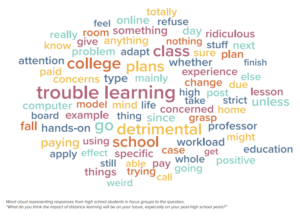
Adult learners
All adult learner participants in the D.C. Policy Center focus groups reported details of busy lives with conflicting schedules between school, family, and work. While the adult learners struggled with their education during the changes required by COVID-19, they largely remained enrolled. When courses could be taught virtually, these students remained engaged.
“So for me, the time was not working. I don’t have enough time because I need to help my three children at home. So right now, I am the therapist, I am the teacher. I try to do everything the teacher says. I try to help my young daughter so she can understand English. It’s very complicated. I didn’t reach my goals. I feel I lost my year from the school.”
— Adult learner
Many adult learners reported facing an additional challenge of overseeing their children’s distance learning in addition to completing their own coursework. These themes came up in the focus group discussions, as well as in findings from other sources. According to a survey conducted by seven adult public charter schools in May of 2020,[xxviii] over 65 percent of D.C. adult learner respondents were also parents of public school students. A little over half of adult learner respondents with children had students in elementary grades or lower grade levels that required a higher level of parent or guardian involvement in distance learning. Forty-three percent of these adult learners’ children are English learners, and 17 percent have an Individualized Education Plan (IEP) or special education needs.
“It did cross my mind [to drop out of my adult education program], and I decided to be more—in fact, what I chose to do is to be more active in school, and all of it was to model to my kids that you have to persevere.”
— Adult learner
The same survey also found that many of the adult learners were concerned with employment, with 20 percent of respondents ranking this as their top concern. Forty percent of adult learners reported losing employment after the public emergency was declared. In addition, in many cases, transportation issues caused by reduced Metrorail and Metrobus service complicated commutes.
“At the current time, I’m working in two jobs. I work overnight from midnight to eight in the morning, and then I go to my part-time job from ten in the morning to two in the afternoon. So trying to juggle both of them is like—when I first started, it was hard, but the more I do it, the more my body gets used to just working two jobs back to back like that. Sometimes it gets hard, but I just keep focusing and keep moving throughout the day, just to keep my energy up.”
— Adult learner
Adult learners also reported obstacles to learning related to technology (30 percent of respondents), and distractions (19 percent). Despite these challenges, 60 percent of adult learners said that they would not change their program of study. With distance learning continuing past spring, adult learners preferred schedules that included class that allowed for interaction with a teacher, small group conversations, and individual meetings over other options.
 School spotlight: How adult learners experienced remote learning
School spotlight: How adult learners experienced remote learning
- At Community College Preparatory Academy, adult learners who did not have access to a device or WiFi were provided with paper packets. Those who could participate online logged onto the learning management system Brightspace to complete lessons, assignments, and assessments. Students received live daily training and had regular check-ins with Student Success Specialists.
- At Maya Angelou PCS, adult learners were at first given workbooks and packets tailored to each career and GED subject course. They later received Chromebooks to participate in live daily classes and use online tools.
Teachers
The initial shift to distance learning was extremely challenging for many of the teachers who participated in focus groups. They had very little time or support from their schools to adapt their mode of instruction. Some teachers did not know how to use online platforms such as Zoom or Class Dojo prior to distance learning. Even with trainings offered by OSSE and their schools, teachers were frustrated at shifting guidance that required them to be proficient in and manage multiple platforms at once. Overwhelmingly, teachers were concerned about returning to in-person learning due to the risks of contracting COVID-19, as well as managing teaching in a new way under new safety guidelines.
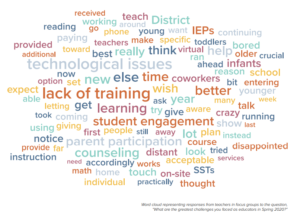
“I even sent text messages to parents who are not email savvy with everything that they needed–links and everything.” — Teacher
Despite struggling to adapt to distance learning, some teachers mentioned that they did everything they could to help parents who were juggling the management of their homes, jobs, and children. If parents found it difficult to check their child’s school platform for assignments and announcements, some teachers would text or call them. Teachers also held office hours and made phone calls after work hours to make it more convenient for working parents. Frequent check-ins from teachers garnered great appreciation from parents and students.
“The teachers were very helpful. We could call them at any time if we had questions. They made themselves available.”
— Parent
System response
D.C.’s education system—government agencies and entities responsible for different aspects of public schools—adapted some accountability policies and provided additional resources during the pandemic to support schools and students in the spring of 2020.
Policy changes
To adjust to a distance learning environment, the Office of the State Superintendent of Education (OSSE) modified some key policies around assessment, graduation, and attendance. Some policy changes were made possible through waivers from the US Department of Education.
Assessment: Given school closures, OSSE cancelled statewide summative assessments for one year in school year 2019-20, including PARCC, DC Science, Multi-State Alternate Assessments (MSAA), Dynamic Learning Maps (DLM), and ACCESS (English learner assessment). Although this meant that learning outcome data are not available for school year 2019-20, this cancellation allowed schools to focus on the shift to distance learning without the additional burden of administering assessments remotely. This cancellation was possible due to a waiver of federal requirements for OSSE provided by the US Department of Education.[xxix] Without assessment results, OSSE also suspended the calculation of STAR school report card ratings for school year 2019-20, but still reported select metrics and aggregate data.
Graduation: The transition to learning at home made it difficult for many high school students to remain engaged and meet graduation requirements, prompting OSSE to provide flexibility around those mandates.[xxx] OSSE allowed LEAs to shorten the school year, decreasing the amount of required instructional time for graduates. OSSE also waived the requirement for certain hours of instruction for high school courses during school closures, as well as the requirement for 100 hours of community service for graduates in school year 2019-20.[xxxi]
Update on graduation rates
Graduation rates were the only outcome data included in the state report card for school year 2019-20. D.C.’s four-year graduation rate in school year 2019-20 was 70.9 percent, up by 2.7 percentage points from 2018-19. This is a large improvement compared to the decreasing graduation rates of the previous two years—perhaps due to relaxed graduation requirements. Black, Latino, at-risk, English learner students, and students with disabilities experienced gains of between two and four percentage points from 2018-19 to 2019-20. However, Latino, at-risk, and English learner students had graduation rates that were lower than they were five years ago.
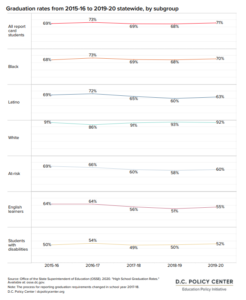
Attendance: Guidelines for tracking attendance required changes to account for distance learning, with students no longer physically present in classrooms. To ensure students would not be counted absent during distance learning, schools updated their school calendars to reflect days that the school was physically closed as non-instructional days. During these days in the spring of 2020, attendance was not collected.[xxxii] Many schools sought instructional waivers from OSSE to forego the requirements for 180 instruction days or six hours of daily instruction.
System supports
The District government, as well as many individual schools, pivoted to provide non-academic resources to students and families, including resources to improve access to technology and continued provision of school meals.
Summer programming
After school year 2019-20 ended, some District government programs provided virtual activities for students in the summer months. The D.C. Department of Parks and Recreation launched a free self-guided summer camp for children ages 3 to 13 that blended games, arts and crafts projects, outdoor exploration, and online engagement with camp counselors, among other things. The Mayor Marion S. Barry Summer Youth Employment Program (SYEP) provided virtual summer jobs for several thousand teens and young adults. D.C. Public Library also launched a summer reading challenge, encouraging kids to read for at least 20 minutes a day.
Distribution of technology and expansion of tech support services: To ensure all students had access to distance learning in the spring of 2020, many LEAs worked to acquire and distribute technology to students including both devices to access online learning and means to connect (such as hotspots or services such as Comcast Internet Essentials) for those students lacking internet access.
Some LEAs already had 1-to-1 device programs in place before the pandemic, wherein each student has a device. This made the transition to distance learning in those schools smoother. DCPS also accelerated its Empowered Learners initiative (ELi), which was a pre-existing three-year commitment to close the digital divide and increase technology integration in the classroom.[xxxiii]
Even as LEAs worked to distribute technology and mobile internet devices, some parents had trouble learning how to use the technology. As a result, they struggled to help their children log into classes on time, check for assignments, and contact their teachers. As time went on, some LEAs were able to offer technical support services to teach parents the functionality of each platform.
Local organizations also stepped in to help bridge the digital divide. The DC Education Equity Fund, established by the Greater Washington Community Foundation, in partnership with Education Forward DC and the DC Public Education Fund, distributed $1.6 million in grants to DCPS and public charter LEAs based on enrollment (and then to schools based on the number of at-risk students), to augment available student technology.[xxxiv] Other local non-profit organizations, like the TraRon Center that works with children in Ward 8, provided laptops to families who needed them.
“[My school] really helped me a lot because when the school sent a survey, they were able to help me to respond to it, and I was able to get technical assistance. And that made a whole lot of difference. I’m really grateful to [my school] for doing that because that changed a lot of stuff in my house.”
— Spanish-speaking parent
 School spotlight: Device distribution
School spotlight: Device distribution
- In the spring, DCPS distributed up to 16,000 learning devices, and with OCTO’s support, up to 10,000 T-Mobile hotspots, to its students for use during the remainder of SY 19-20 and into the summer.
- DC PCSB, with support from OCTO, coordinated a bulk order of 1,600 T-Mobile MiFi devices for interested public charter schools in April 2020. Public charter LEAs also delivered devices and hotspots to individual students at a large scale.
Meal distribution: The District’s public schools regularly serve over one million free and reduced-price meals per month during normal school year operations[xxxv] through the National School Lunch Program, School Breakfast Program, and Summer Food Service Program. Community eligibility allows schools to serve free meals to all students if at least 40 percent of students at the school participate in SNAP. About 60,000 students in D.C. attend schools that meet this requirement, and these students rely on the meals during non-pandemic times. The pandemic exacerbated the financial instability of many of D.C.’s low-income families, making these meals a critical service to continue in the spring of 2020.
Through waivers from the United States Department of Agriculture (USDA), schools were able to provide students with food during school closures. In March 2020, 72 DCPS schools, public charter schools, and non-profits began hosting distribution sites for meals and groceries throughout the city, as well as supporting home delivery services for essential resources. During the summer, the Department of Parks and Recreation (DPR) opened additional distribution sites. Multiple meals were available to families, and meals could be picked up at any school (not limited to where students were enrolled).
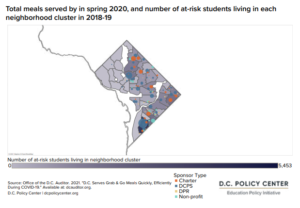
Aside from grab-and-go meals, the federal Pandemic Electronic Benefits Transfer (P-EBT) program provided $387.60 per child so that families of children who were eligible to receive meals under the National School Lunch Program could purchase food at retail stores accepting SNAP benefits, as well as food for delivery from Amazon.
“One other big thing was that my school also provided lunches for a good 3-to-4-month period. They would just send out these emails or send out notifications about when students in the area and families could go in and get lunch from them.”
— Parent
A report from the Office of the D.C. Auditor found that 96 percent of at-risk students had access to at least one meal site located in their home neighborhood cluster in the first month of the COVID-19 pandemic. In addition, areas with large numbers of at-risk students had more meal sites, with high distribution levels. Ballou High School, located in the Congress Heights, Bellevue, and Washington Highlands neighborhood cluster— where the greatest number of at-risk students live—served more than 165,000 meals from March to July 2020.
These system-level responses—policy changes, efforts to close the digital divide, and to distribute school meals—show ways in which District entities came together to create supports needed by schools and students amid the crisis. The policy changes gave schools more flexibility around assessments, attendance, and graduation during a time when everything was uncertain. And mobilizing in new ways to provide meals and technology made a meaningful difference for many individual students and families.
DME COVID-19 school leader LEA calls
In addition to the provision of meals and technology, efforts to coordinate services across LEAs have also improved. Since March 2020, the Office of the Deputy Mayor for Education (DME) has led over 75 virtual meetings alongside DC PCSB, DCPS, OSSE, and other agencies for LEA leaders. These meetings have been held in response to the rapidly-changing understanding of the public health emergency, and have covered a range of topics relevant to school communities including establishing closure protocols, virtual learning best practices, meal distribution, city resources, vaccination availability, and school-level operational adjustments. From March through mid-April 2020, these calls took place daily, and then occurred two or three times a week from mid-April to August 2020. Since September, they have been hosted twice a month. The virtual meetings are well-attended with an average of 150 participants per call, and they will continue through school year 2020-21.
 School spotlight: Social studies standards
School spotlight: Social studies standards
Aside from COVID-19 induced policy changes, in July 2020, the DC SBOE and OSSE launched a three-year effort to review and update the District’s social studies standards, which were last revised in 2006. DC SBOE convened an Advisory Committee of 26 members, representing pre-kindergarten to grade 12 teachers, school district leaders, parents, and students to draft the guiding principles and make recommendations to OSSE on how the state standards should be changed. DC SBOE’s goals were to make the District’s standards culturally responsive and anti-racist, strengthen coursework on democratic principles, and promote civic engagement.[xxxvi] To this end, the Advisory Committee proposed changes to state-wide standards that would include comprehensive coverage of human rights principles, a focus on the intersectionality of justice movements, studies on power and bias, environmental literacy, an understanding of democratic citizenship, global perspectives, and first-person accounts of marginalized groups.[xxxvii]
- This year, in response to the global pandemic and increased awareness of police brutality and racial injustice, DCPS also created its Living though History Pre-K-12 Cornerstone as a cross-disciplinary school-wide approach to school re-engagement, entre to use of technology, and vehicle for social-emotional learning and trauma-informed pedagogy for the beginning of the school year.
Key challenges
Schools and families did their best to adjust to distance learning at the start of the pandemic in the spring of 2020. All at once, families were balancing work and other routine demands, while guiding distance learning for their children and assuming full-time childcare responsibilities for younger students. Schools and teachers had to rapidly learn how to use technology for instruction and distribute devices to students at home.
Common challenges emerged from this experience in the spring of 2020, including mental health concerns, inequitable access to technology (the digital divide), communication, and reaching students who needed additional supports.
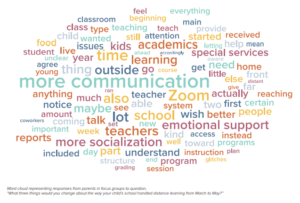
Mental health concerns
The COVID-19 pandemic introduced new mental health concerns for many, and efforts to slow its spread through social isolation and closures likely exacerbated stress levels: at least one in every three adults in D.C. reported symptoms of anxiety or depression in late April of 2020.[xxxviii] Students were experiencing anxiety as well: among the 475 responses to a parent survey carried out by ConnectED in April of 2020,[xxxix] 41 percent thought their children were somewhat anxious, and 13 percent thought their children were very anxious. The D.C. Policy Center focus groups corroborated these findings. Parents reported that their children experienced a range of emotions during the spring of 2020, including feeling anxious and upset about not seeing their friends.
The need for mental health services increased at a time when schools–usually a key provider of school-based mental health professionals, opportunities to socialize, and health screenings–were closed.[xl] In a report from PAVE,[xli] a group of parent leaders reported believing schools took thoughtful steps to bridge this gap using virtual channels, but parents still lacked all the mental health resources they needed. For example, they appreciated morning meetings, as they allowed teachers to check in and see how students were doing. They also appreciated weekly calls from school staff. However, many parents expressed interest in more opportunities to connect with mental health supports aside from teachers. These parents reported that they were not aware of additional school-based mental health services.
Digital divide
The structures and resources that students needed to participate fully in distance learning differed from those they use for in-person learning. First, each student needed their own device to use for school work–functional and compatible with learning platforms and apps used by schools. Second, each household with students needed high-speed internet with adequate download and upload speeds to allow for video streaming and other virtual activities, as well as sufficient internet capacity for all members of the household to use technology at the same time. Third, students and family members assisting younger learners needed to be digitally literate, which meant either being experienced using learning platforms and applications, or receiving necessary training and technical support to develop these skills.
“Some days were online, some days packets. Sometimes they would have to be online for a couple of hours. They used a combination of Instagram Live and Canvas and it was difficult trying to juggle the two.”
— Parent
Despite many distance learning plans including a web-based component, the learning environment was impaired by the inequitable access to technology when students shifted to distance learning. This went beyond having access to devices: parents and teachers who were not comfortable with technology had trouble managing multiple platforms. Some parents did not understand where assignments or grades were being posted, while teachers found it challenging to manage multiple video conferencing platforms. Students also reported experiencing platform fatigue from having to log onto multiple websites and different user accounts to access the necessary information.
Over the summer and in the fall of 2020, city officials and school leaders made additional efforts to bridge this digital divide.
Communication
Communicating with teachers, students, and parents during distance learning was difficult. Many parents, especially parents of younger students, found they had to dedicate a lot of time and energy to the schooling of their children. Parents of elementary school students, whose virtual curriculum demanded more parental engagement, found distance learning to be time consuming and stressful.
Parents who were still working had a tough time balancing their jobs and their childcare responsibilities. An estimated 78 percent of parents of elementary school-aged students were employed before the pandemic,[xlii] and many residents who left the labor force cited the need to take care of children (as well as concerns over contracting or spreading COVID-19) as their reason for leaving.[xliii] In addition, many parents had to learn material to support their children’s learning, which was time consuming.
“I sent out a survey to parents to find out when individual students and families were available day to day, so I could set accessible office hours.”
— Teacher
To communicate virtually, schools worked hard to maintain contact with students outside of scheduled class time. Teachers scheduled office hours and held check-ins. Many schools planned daily or weekly check-ins with teachers, office hours with teachers, and some non-teaching staff check-ins (distance learning advisors, for example). Many also communicated with parents through weekly newsletters, resources on their websites, regular town halls, webinars, or messaging apps. DCPS Student Wellness Check Teams also reached out directly to students.
“I communicated heavily via text messages with my parents. I had some parents who asked if they could have individual reading sessions, which I gladly jumped on Zoom for, and we did a reading lesson. And a lot of the times, their kids just wanted to talk and see me. I tried to make all of those things possible. I especially tried to make sure parents knew what was going on and also knew that they could get in touch with me whenever they needed or wanted to.”
— Teacher
However, parents reported significant variation in how they interacted with their children’s schools. Some schools were proactive and clear, while others reportedly sent conflicting messages or changed course too frequently. This was especially confusing for parents of multiple children attending different schools; parents often experienced a lack of consistency across schools and found themselves managing shifting schedules and expectations.
“The social work team had check-ins with each classroom on a weekly basis.”
— Teacher
In addition, some parents reported not knowing how well their children were doing academically. They felt their children did not receive enough feedback on individual assignments and reported not knowing if their children had failed to complete assignments.
Reaching students with additional needs
Distance learning often disproportionately and negatively impacted students who received additional supports for learning before the pandemic, such as students with disabilities and English learners.
Students with disabilities: Approximately 16 percent of students who attend public or public charter schools in D.C. were eligible to receive special education services in school year 2019- 20. Despite their best efforts, some special education teachers faced obstacles when developing virtual lesson plans that aligned with their students’ IEPs. Many of the services that students with disabilities require are difficult to deliver virtually. For example, some students need assistive technology such as voice recognition programs that they may not have at home. Others need speech, occupational, or physical therapy services they are unable to receive at home. In addition, some students with disabilities need the structure of traditional school-based instruction to thrive.
 School spotlight: Serving students with disabilities
School spotlight: Serving students with disabilities
- At Washington Latin PCS, special education teachers worked with general education teachers to ensure principles of Universal Design for Learning (a framework for removing barriers to learning) were implemented. Case managers were also assigned to contact families, provide daily briefings, schedule check-ins, and hold office hours. The school also offered to provide compensatory services if necessary.
Reflecting these challenges, special education was one of the top two concerns in parents’ calls to the Office of the Student Advocate’s hotline in school year 2019-20: 24 percent of calls were related to special education—mostly related to IEPs, special education placement, and inadequate support.[xliv] Special education was also among the top three most common disputes filed with the Office of the Ombudsman for Public Education in school year 2019-20.[xlv]
“From my experience, there was no additional support provided for those students [with Student Study Teams (SSTs) and IEPs], and as much as I tried to provide that individual support, it’s not the same as getting help from the reading instruction teacher or the math specialist.”
— Teacher
In the D.C. Policy Center focus groups, most parents with children who had IEPs echoed these concerns, reporting that their children with IEPs had difficulty adjusting to the new way of going to school. They often did not feel supported by their schools or have access to all the services their children were accustomed to receiving, and some parents did not feel equipped to provide the specialized attention and services their children normally received in school.
“For my students who were most vulnerable, I definitely developed a stronger rapport, as I occasionally checked up on them… [my school] was smaller than most schools and able to provide a lot of resources for parents, for families affected by COVID, and even staff.”
— Teacher
Teachers in the focus groups reported similar challenges—they did not feel their schools were doing enough to reach out to students, and in some cases had a hard time adapting lesson plans for students with disabilities. The assessment and evaluation process to identify students who needed IEPs was also more challenging in a virtual environment: The Office of the Ombudsman for Public Education reported that an abnormally high number of its cases related to special education concerned students whose evaluations had been delayed because they needed to be completed in person.[xlvi]
English learners: Distance learning proved challenging for students who were learning English at school, as it could be more difficult for them to navigate learning platforms in English in order to fully participate in live sessions or complete independent work. If English learners’ parents did not speak English, those parents sometimes found it difficult to communicate with teachers or staff. This made it challenging to manage their children’s distance learning or to be informed about device pick-up or other resources. In cases where English learners could not participate in class and did not speak English at home, their exposure to English was limited and made it even more difficult to learn the language.[xlvii]
“The packets and study aids were in English only, and because I don’t speak or read in English, it was hard for me to help my younger children. I would use an app to translate the packet or homework. I would ask my oldest daughter to correct it for me. I felt bad because I didn’t want to distract her from her own homework. Not having study aids in Spanish was very stressful for me and my entire family.”
— Spanish-speaking parent
“Some of us who speak English tried to help other parents, but we have our own households that we have to take care of. It was hard to see how parents who speak limited English were being ignored and left without information.”
— Spanish-speaking parent
 School spotlight: Resources for English learners
School spotlight: Resources for English learners
Many D.C. schools provided translations of communication and learning materials and had staff members available to translate to non-English speaking families.
- DCPS offered translations in Spanish, Amharic, French, Chinese, and Vietnamese.
- At DC Bilingual PCS, Spanish and English versions of materials were available.
- DC Prep PCS partnered any non-English speaking family with a staff member who speaks their home language. Schools also utilized Language Line when there was no translator available.
In addition to translation services, schools also provided resources for families related to financial support, physical and mental health, utilities, and COVID-19.
- Mundo Verde PCS listed resources for mental health services, financial help, unemployment, homelessness, transportation, and hygiene.
- Paul PCS provided resources for families on how to talk to their child about the novel coronavirus.
Lessons learned
The implementation of and responses to distance learning across the District of Columbia are still evolving as the pandemic persists. Nonetheless, some observations and lessons emerge from the initial shock to the city’s education system from the COVID-19 pandemic. These lessons learned in the early days and months can be useful both now, and as schools and families plan and experience recovery in the coming years.
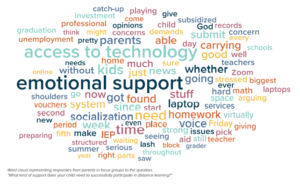
1. Be intentional with big changes
When the pandemic began, in many cases the switch to distance learning was swift, and was believed to be temporary. Immediate continuity of instruction was the focus for many, which often meant continuing with the traditional cadence of in-person school without adapting to a new, virtual context. Even from a practical standpoint, the digital divide and gaps in digital literacy meant that staff, students, and family members were not ready to fully engage. Taking the time to pause and assess needs and available resources may have led to a more systematic and holistic approach to distance learning in the spring of 2020. In some cases, schools were able to step back and adapt better to meet students’ distance learning needs in the fall of 2020.
2. Be innovative
Learning at home, students’ needs became more distinct from one another than they were in the classroom, as students experienced different learning environments with varying schedules and varying access to devices and internet. In some cases, schools and teachers devised creative solutions to solve these challenges such as translating instruction and materials, providing one-on-one support, and rethinking attendance tracking to allow students to begin the day remotely. Across schools, OSSE hosted a series of Teaching and Learning webinars last spring, where staff could hear from OSSE subject experts, share best practices, and discuss what was and was not working well. Innovative practices could ease the transition back to in-person school and future school planning, with an opportunity for schools to seek and embrace equitable solutions to learning disparities. Since the pre-existing inequities were so great, the effects of the pandemic will only set many students further behind, and schools will need to be even more innovative with additional and customized supports to address that challenge.
3. Focus on needs beyond the classroom
Throughout the pandemic, students’ home and school lives have been completely intertwined–and students are dealing with unprecedented challenges on both fronts. This makes it even more important to meet students’ needs outside of the classroom and stay aware of how students, families, and teachers experience school outside of academics. Many schools took steps to make mental health supports available, distribute technology devices, and provide meals and groceries to address families’ basic needs. In some cases, creating consistent schedules and user-friendly platforms made it easier for parents and students to stay on track. By putting students’ non-academic needs starkly at the center of their educational experience, the pandemic has demonstrated the importance of a holistic approach in maximizing student well-being as much as their academic achievement.
4. Prioritize family and community engagement
Parents and students noted communication as a key challenge over the past year. School schedules and expectations changed often and drastically beginning in the spring of 2020, and families were expected to be more involved with learning than ever before. The development and maintenance of strong relationships between schools and teachers and families and students improved the distance learning experience, but where communications failed, students and families struggled. Listening to families, students, and teachers and communicating transparently will be critical as schools transition back to in-person instruction and work to rebuild trust where it has been lost.
Reflections on spring 2020
“We understood that there were families who had multiple children in the school. It would be impossible if they had one child in fifth grade, one child in first grade, and only one device. How would those students get instruction if they had to share one device for different classes? So we had staggered times for each grade level to have their live instruction on Zoom.”
— Teacher
“Again, I was really pleased with communication. I had my daughter’s teacher’s cell phone number, so I could easily check in with them and say, ‘Did she do all her minutes? What is she missing?’ The teachers gave a weekly report that was really helpful.”
— Parent
“I would definitely tell my school leadership to be understanding of how the students and each of their environments are in a fragile state—some worse than others.”
— High school student
“My daughter’s teacher was just phenomenal as far as checking in with those kids, because they needed that check-in.”
— Teacher
“During that whole transition from school to home, my school definitely provided support. For example, if a student didn’t have any type of technology at their home like a computer or any type of Wi-Fi, they provided us with a hotspot or gave us connections through companies that did give out free Wi-Fi during the beginning of the quarantine period. They let us take home our computers and our iPads, so there was definitely support there.”
— High school student
“I appreciated that my school allowed teachers the flexibility to create their own schedules. They understood that we were all responding to the pandemic in our own ways, and people had their own children or parents or themselves to take care of. And I appreciated that flexibility.”
— Teacher
“My daughter’s school started sending out Google Forms, asking, “Are you okay? How are you feeling today? What are you in need of?” Some of the options were financial assistance, virtual assistance, food, access to laundry facilities, and more. They did that every week, and they contacted me immediately to follow up.”
— Parent
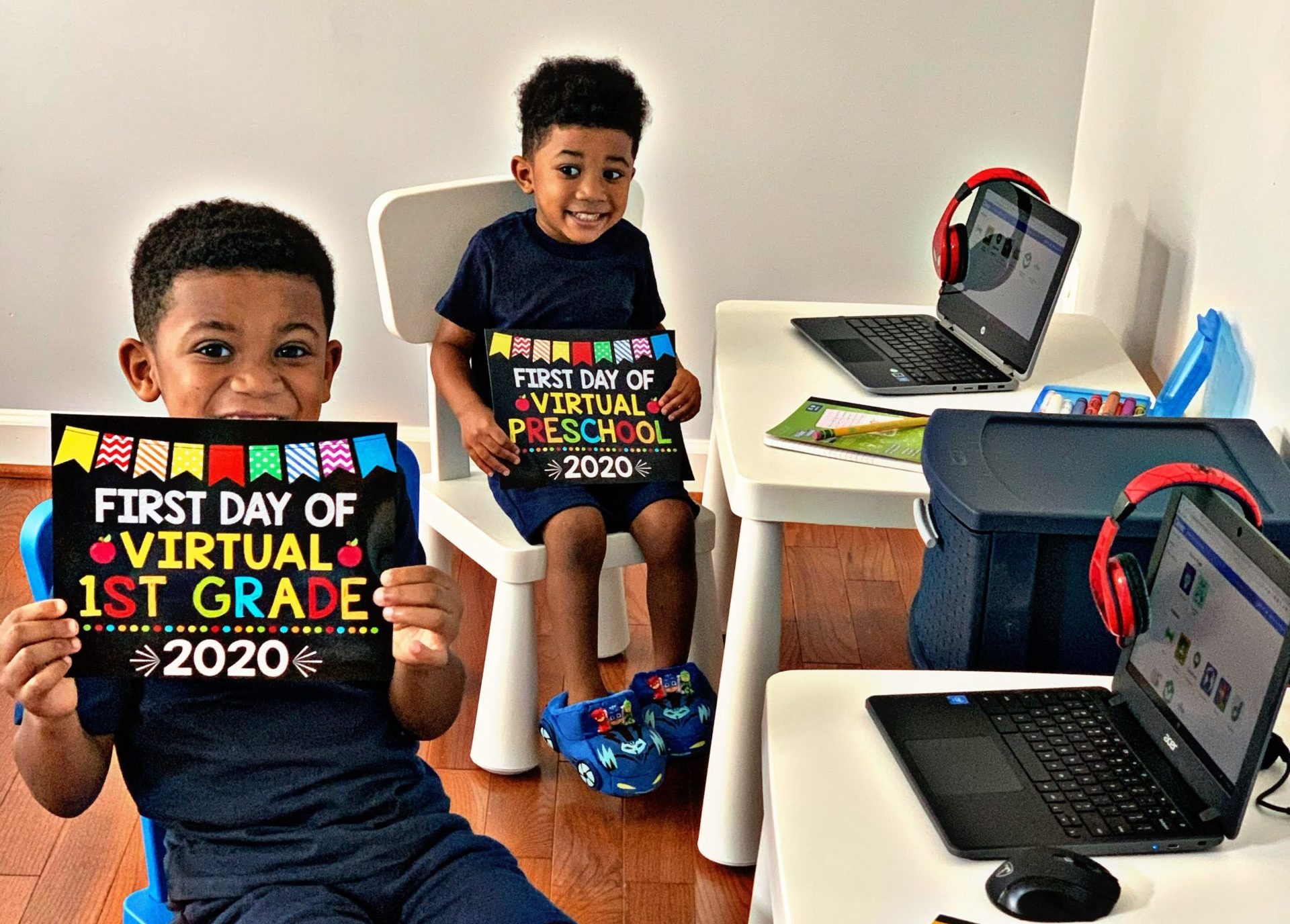
Looking ahead to school year 2020-21 and beyond
In the fall of 2020 as the pandemic persisted, DCPS and public charter schools largely continued with distance learning, but some began to explore limited in-person offerings. In September 2020, 13 DCPS schools allowed small groups of students to attend in-person programming that included tutoring, physical education, and career and technical education.[xlviii] Some public charter schools also provided in-person options at the start of the 2020-21 school year, including the city’s two largest charter networks: KIPP DC PCS and Friendship PCS. By February of 2021, all DCPS schools[xlix] and 86 public charter schools offered some amount of in-person learning.[l]
School year 2020-21 update
To learn about stakeholders’ experiences in the fall with distance learning, the D.C. Policy Center conducted another round of focus groups with largely the same participants as the first round (33 out of 48 returned, and nine new participants were engaged). Overall, parents reported improvements over their spring experience– most parents said that schools, teachers, and individual school staff were more organized and prepared for teaching in the virtual environment. Parents also stated that schedules and expectations were more clearly set in the fall as compared to the spring. Students in these focus groups reported that the fall was more challenging: specifically, the amount of screen time was too much for them and workloads were more intense.
Although some students are returning to classrooms for in-person or supervised distance learning (as of February 2021) and COVID-19 vaccinations have started with priority groups across the city, distance learning is likely to continue as the best option for some time. Many families in the focus groups communicated that distance learning was still not ideal, but given the health and safety circumstances, very few were ready to return to in-person learning. This was also the case in a September 2020 PAVE survey of 939 families: only 33 percent reported that they would probably or definitely send their children to school in-person for a hybrid option in November of 2020.[li] In the same survey, white families were more likely to consider in-person learning in the fall, with 45 percent reporting that they would probably or likely return to a hybrid model.
Teachers also reported discomfort with returning to in-person learning in the D.C. Policy Center focus groups. They were concerned that they would be exposed to COVID-19 at work, that schools would not provide adequate Personal Protective Equipment (PPE) or cleaning supplies, or that schools would not take other key precautions including asymptomatic testing. They also felt stressed about the additional work involved in preparing and delivering lesson plans both virtually and in-person.
Now that distance learning has been in place for almost a full year, changes in technology access, new information on learning loss, and low levels of student well-being shed additional light on where the District needs to focus both in the near and long term to ensure an equitable recovery amidst lower levels of enrollment.
Improved access to technology
It is difficult to know the precise number of students who lacked access to technology in the fall of 2020, but computer and mobile internet device availability has likely improved since the spring of 2020.
At the start of school year 2020-21, a survey of LEAs conducted by the Office of the Deputy Mayor for Education (DME) showed that there were an estimated 74,250 devices ready for distribution to students in the fall of 2020 compared to an estimated 93,987 public school students.[lii] Out of these devices, 45,000 of these were available to DCPS students, and by February of 2021, 32,000 devices had been distributed.
In addition, at the start of the school year, an estimated 63,390 internet access points were available through the city’s Internet for All, LEA WiFi hotpots, LEA cell-enabled devices, and LEA home broadband packages. These access points do not all provide the same quality of internet service, but represent an improvement or a new source of internet for students. Most of the internet access points were available through the city’s Internet for All initiative, and as of February 2021, 9,000 students have agreed to participate in the initiative (with 25,000 allocated spots).
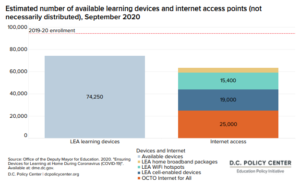
Parents also report that the availability of devices and internet has improved, although some issues with access persist. In a PAVE Back to School survey of 939 families, 94 percent of respondents reported that they had internet access–although those with basic or lower-cost internet experienced glitches that made classes hard to follow; this was especially true for parents working from home or with multiple children. In the same survey, nine percent reported that they still lacked a device.[liii] In a Flamboyan Foundation survey of teachers with 800 respondents, teachers reported that the top three concerns for their students’ families were technical support, high-speed internet access, and device access, even in the fall of 2020.[liv]
Learning loss
Amidst so much unforeseen hardship and stress during the pandemic, distance learning in D.C. required a tremendous amount of effort from parents and students as well as teachers and school leaders. Despite their great efforts, distance learning has not been as effective as in-person learning for most students, according to a December 2020 report from EmpowerK12.[lv] The full academic (and non-academic) impact of COVID-19 and school closures on students will not be known for some time, but fall assessment data from a sample of students at DCPS and 11 public charter LEAs suggest that those students likely lost four months of learning in math and one month in reading over the last year. And distance learning has likely been more challenging for students who were designated as at-risk of academic failure during school year 2019-20: students designated at-risk in this sample likely lost five months of learning in math (half a school year) and four months in reading.[lvi]
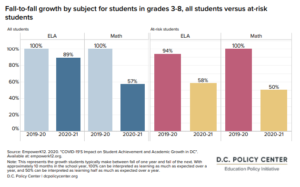
Concerns about student well-being
The pandemic has created new sources of stress for many individuals and households. There is no systemwide data point on mental health concerns for students, but a fall 2020 D.C. Student Well-Being Survey starts to tell the story. Over a time span of four weeks starting in late September 2020, nearly 2,500 students in grades 3 to 12 from 22 D.C. public charter schools anonymously completed the D.C. Student Well-Being Survey, administered by EmpowerK12 in collaboration with other partners.[lvii] Students reported anxiety related to the pandemic (77 percent were concerned that their family would be exposed to COVID-19), and nearly half (45 percent) reported that their family’s financial situation had become somewhat or significantly more stressful due to the pandemic. Nearly one in five students had recently experienced the loss of a family member in their household. When asked how confident they are in their ability to succeed during distance learning, high schoolers were the least confident.
Enrollment decline
Preliminary audited enrollment numbers show a decrease in enrollment (974 fewer students) from school year 2019-20 to school year 2020- 21, indicating that some students may have left for other jurisdictions, homeschooling, private school, or childcare centers.[lviii] However, D.C. was expecting to gain enrollment of over 4,000 students based on enrollment projections, meaning that school year 2020-21 enrollment is much lower than anticipated.
According to OSSE, these lower-than-estimated enrollment numbers have been driven by very young students and by adult students: 2,000 fewer students enrolled in pre-kindergarten and adult education than last year. This corroborates with the experience of younger grades being particularly difficult to continue virtually, and some adult learners having conflicting responsibilities to which they must attend. OSSE also reported a preliminary increase of over 200 students registered for homeschooling in school year 2020-21.
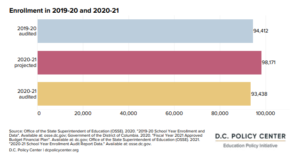
Recovery
Pandemic-related school closures and the subsequent transition to distance learning in spring 2020 were arguably the most significant and abrupt changes that D.C.’s public schools have experienced in many years; these rapid shifts and their intense upheaval left students, teachers, and parents reeling as they adjusted to new methods of instruction and communication.
Despite the disruption, there have been bright spots in the responses of the education community and city alike. Teachers have found ways to close gaps in communication and engage with students and their families when suddenly disconnected from daily face-to-face interaction. Stakeholders from across the system have come together to address students’ and families’ basic needs, and schools and educators have adopted innovations in instruction, information-sharing, and student support. The District government has made significant investments in education and COVID relief, at a time when other cities have experienced cuts. Philanthropic support has added needed resources as well.
Reflections on fall 2020
“In our adult learning classes, the school asked what were the best times for us to do our homework and our school work, and I told them that for me and for many of us, it’s at night. So this new year, they adjusted the program so that I can do most of my work at night.”
— Adult learner
“In years past, I would love to have had the engagement that I have now with the parents sitting next to the students. I’m able to speak to a parent immediately when I need to, and I think that that has improved 100 percent.”
— Teacher
“One on one sessions help the students to focus only on me, and it’s a lot easier for them to block out all of the distractions. And I’m not having to worry about multiple students and all of the other things that come with technology. I can just focus on that one student, and they can focus solely on me.”
— Teacher
“I think that the fall has been much smoother, much more organized. The students know what to expect. The teachers always put the assignments in the same places, and the parents can look at what the kids are doing.”
— Parent
“At my child’s school, they’re starting to do group sessions with the whole school—group social, emotional sessions. The guidance counselor and the social worker are always there. They’re always sending out messages that say, ‘If you notice something in your child that worries you, feel free to reach out to us.’”
— Parent
“Distance learning is now more organized… last year when we first started, they would have everybody who was taking a certain class in that one period…So it could be 50 kids in the virtual class at one time, and it got overcrowded. But now they split it up, and the classes are divided equally, and it’s easier to learn.”
— Student
“I’ve noticed that teachers are more proactive and saying, ‘Hey, your kid didn’t do as well on this as he usually does.’ They’re sending an email about it, rather than waiting for the specified progress report.”
— Parent
Having gained experience over the spring, public schools have, by many accounts, made great improvements in the organization, delivery, and accessibility of distance learning. However, many agree that distance learning is not a perfect substitute for in-person teaching and learning, even if some families are not ready to return to in-person school. Signs of learning loss, the pandemic’s impact on student well-being, and under-enrollment are early indicators that the COVID-19 health crisis will have a lasting impact on education in D.C.
With indications that the impacts of the pandemic are likely to linger into school year 2021-22, public schools in D.C. must figure out how to deliver education and supports for students in this new and challenging environment over the long term. Last year, the city increased per-pupil funding by 3 percent and increased funding for school-based mental health by $3.3 million. Now, as the FY2022 budget is being developed, there are discussions about developing a systematic approach to outdoor learning (where risk of COVID-19 spread would be greatly reduced), and providing tutoring and summer learning opportunities, among other needed responses. Parent leaders across the city are calling on District leaders to continue to meet and expand support for families’ basic needs by bolstering distance learning, creating a safe and equitable plan for safely returning to school in-person, continuing investment in systems that support students and their families, and improving cross-sector coordination and communication among LEAs.[lix]
Students, families, teachers, and schools have shown signs of great resilience over the past year, and the city needs to consider long-term systemic changes to match their strength. Amid the unprecedented challenges of the pandemic, the District’s education system has a once-in-a-generation opportunity to identify, develop, and adopt models of education coupled with the necessary non-academic supports to enable all students, all schools, and all teachers to emerge from this crisis stronger than they were before.
Reflections on next steps
“I want D.C. to invest in our Black children. The District should recognize that educating our kids to go to Silicon Valley and make good money will allow us to get ourselves out of these cycles of poverty that we talk about and pretend we don’t know how to solve. We have the children here who can make those answers happen. We have the kids here who absolutely can change the world and make it better.”
— Parent
“As teachers, we thrive on that interaction with students and helping them learn and grow. So I’m just excited to get back to seeing student faces, and I’m anxious to get back because I know there are big gaps we need to close. And I’m just ready to get started on that.”
— Teacher
Data sources
The D.C. Policy Center is grateful to present and analyze publicly-available data from the following key sources for this report.
Adult Public Charter School Survey
In May 2020, seven adult public charter schools surveyed their learners to find out about these experiences. Of the 3,486 students who received this Citywide Adult Education Survey, 1,832 submitted responses, a 53 percent response rate. More than 92 percent of survey respondents were people of color, including 58 percent who were Latino (compared to 52 percent of adult learners who identified as Latino in 2019) and 26 percent who were Black (compared to 44 percent of adult learners who were Black in 2019).
D.C. Policy Center focus groups
In August of 2020 in collaboration with Bridges, the D.C. Policy Center conducted seven focus groups and six one-on-one interviews with parents, educators, adult and alternative learners, and high school students to hear about distance learning in the spring of 2020. The focus groups included 48 participants from across the city, with a focus on Spanish-speaking parents and parents living in Wards 7 and 8. A second round of focus groups occurred in November of 2020 to follow up on findings and distance learning in the fall.
DME Edscape Beta
This tool was launched in 2019 and provides interactive visualizations and downloadable data sets that cover these topics: school-age population and public school students, public schools, facilities, enrollment patterns, and neighborhood factors. State of D.C. Schools includes information from these datasets (2019-20 numbers made available to us in advance of publication): • Public School Students by Special Need Categories • Public School Enrollment by Race and Ethnicity
DME Parent Survey
The DME received more than 15,000 responses representing 25,000 students in June of 2020. Parents were contacted to complete the survey by email, aside from some limited responses gathered in-person.
DME Technology LEA Survey
DCPS collected information in their own survey, and 61 out of 66 public charter LEAs responded to the DME survey in August 2020.
EmpowerK12
EmpowerK12 analyzed assessment results of nearly 30,000 students in traditional public schools and public charter schools and surveyed wellbeing of 2,500 students in grades 3 to 12. State of D.C. Schools includes information from these reports:
- COVID-19’s Impact on Student Achievement and Academic Growth in DC
- COVID-19 and Student Well-being
Government of the District of Columbia
The D.C. government provides information on vaccine distribution, food resources, testing resources, and additional COVID-19 surveillance.
The D.C. government also prepares a budget that includes projected student enrollment.
Office of the D.C. Auditor
The Office of the D.C. Auditor provides the D.C. Council with recommendations after conducting performance audits, non-audit reviews, and revenue certifications. State of D.C. Schools includes information from this report:
- D.C. Serves Grab and Go Meals Quickly, Efficiently During COVID-19
OSSE Adjusted Cohort Graduation Rates
OSSE publishes statewide graduation rates by school for DCPS and public charter schools. The process for reporting graduation requirements changed in school year 2017-18. At-risk graduation rates are only available for school years 2017- 18 and 2018-19. State of D.C. Schools includes information from these datasets:
- 2019-20 Adjusted Cohort Graduation Rates
- 2018-19 Adjusted Cohort Graduation Rates
- 2017-18 Adjusted Cohort Graduation Rates
- 2016-17 Adjusted Cohort Graduation Rates
- 2015-16 Adjusted Cohort Graduation Rates
OSSE DC School Report Card
First published for the 2017–18 school year, the OSSE DC School Report Cards present key school-based information and STAR ratings for all D.C. public schools. The report cards provide an overall rating and more than 150 data points to communicate how a school is doing with all its students, in addition to helpful information about the school itself. State of D.C. Schools includes information from these datasets:
- Teacher, School Leader, and Health Staff Information
- Graduation Rate
OSSE Distance Learning Plans
All LEAs submitted distance learning plans to OSSE for the spring of 2020. These learning plans were intended to cover the remainder of school year 2019-20.
OSSE Enrollment Audits
Annually, OSSE conducts an enrollment audit to determine the number of students at each public school in the District. These files contain the audited enrollment by school and grade. State of D.C. Schools includes information from these datasets:
- 2019-20 School Year Enrollment and Data
- 2018-19 School Year Enrollment and Data
U.S. Census Bureau
The Census Bureau’s National Survey of Children’s Health (NCSH) provides data on multiple aspects of children’s lives such as mental health, access to quality health care, and the child’s family, neighborhood, school, and social context.
The Census Bureau’s American Community Survey (ACS) Public Use Microdata Sample (PUMS) files are records from individual people or housing units.
Photo credits
Feature photo: Ivan Radic (Source). Introduction section header photo: Phil Roeder (source). Schools and students in school year 2019-20 section photo: DC Public Charter School Board (source). Distance learning in spring of 2020 section photo: DC Prep (source).
